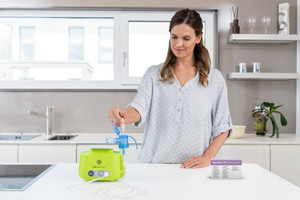
Inhalation of hypertonic saline solution efficiently loosens mucus from the lungs. The inhalation solution is also suitable for children. Studies have shown that infants with bronchiolitis or babies, toddlers and preschool children with cystic fibrosis benefit if they inhale hypertonic saline solution.
Hypertonic saline solutions contain a higher salt content than isotonic saline solutions (= NaCl 0.9%). With their higher salt concentration they trigger osmosis, and so liquify the mucus in the airways. This makes it easier and more effective for children to cough up the mucus from the lungs.
PARI offers two hypertonic saline solutions: MucoClear 3% and MucoClear 6%. Both solutions are suitable for children. Inhalation with hypertonic saline solution has the same effect as the bracing climate by the sea – but is always readily available.
NB: Hypertonic saline solutions can initially irritate the airways at the start of the inhalation therapy, especially in babies. In this case, it is advisable to slowly increase the salt concentration or to premedicate with a bronchodilator (such as salbutamol).

Children – like adults – inhale hypertonic saline solutions with a jet, ultrasound or membrane nebuliser such as the PARI BOY or the PARI COMPACT2. PARI has masks and mouthpieces for inhalation devices to suit infants, toddlers and children to make inhalation therapy as pleasant and effective as possible.
Bronchiolitis is an acute inflammation of the smallest airways (= bronchioles). The disease is especially prevalent in infants. It is triggered by a range of viral infections, whereby the most common pathogen is the RS-Virus (RSV). Other viruses (human metapneumovirus or adenovirus) can, however, produce similar symptoms.
Infants catch bronchiolitis from other babies, children or adults through droplet infection (the air we breathe). The first signs of infection are a runny nose, fever and a slight cough. Within a few days the child has increasingly severe breathing difficulties. The cough gets worse and becomes wheezy. The infant becomes short of breath and will in some cases require hospitalisation.
Some studies1 have shown the following: Treatment with hypertonic saline solution 3% in children with acute viral bronchiolitis treated in an inpatient setting can shorten hospitalisation - and improve clinical severity. However, the study data are not unequivocal.
Cystic fibrosis (CF) is a congenital metabolic disease that is caused by defects in the CFTR gene (CFTR = Cystic Fibrosis Transmembrane Conductance Regulator). It affects the salt balance in the body and the body’s own secretions thicken. This has a pronounced effect on the lungs where a great deal of thick mucus is produced that can then build up. This in turn forms the ideal breeding ground for pathogens and can damage the tissue in the lungs.
For this reason, even babies with CF have to use their inhalation therapy every day to release the mucus from the lungs and so combat the damage to the lung tissue and a reduction in lung function. Inhalation with hypertonic saline solution is a tried and tested method in cystic fibrosis. It improves what is known as mucociliary clearance in babies, toddlers and preschool children. The inhalation solution is well-tolerated, as shown in a range of studies2–4.
Your child needs to inhale with a nebuliser? Here you can find advice and ideas:
1 e. g. Shobha Sapkotaet al., J PakMed Assoc 2020:1–10.
2 Stahl M. et al; Preventive Inhalation of Hypertonic Saline in Infants with Cystic Fibrosis (PRESIS). A Randomized, Double-Blind, Controlled Study. Am J Respir Crit Care Med. 2019 May 15;199(10):1238-1248
3 Ratjen F, Davis SD, Stanojevic S, Kronmal RA, Stukovsky KDH, Jorgensen N, Rosenfeld M. Lancet Respir Med 2019 online publication.
4 Subbarao, P. et al. Lung clearance index as an outcome measure for clinical trials in young children with cystic fibrosis. A pilot study using inhaled hypertonic saline. Am J Respir Crit Care Med 188, 456–60 (2013).
An article written by the PARI BLOG editorial team.
© 2025 PARI GmbH Spezialisten für effektive Inhalation